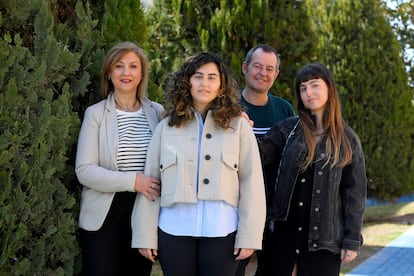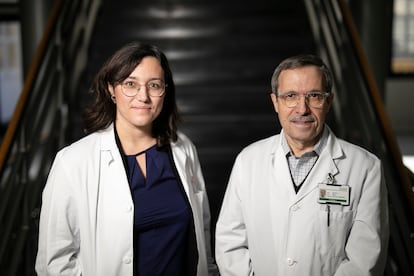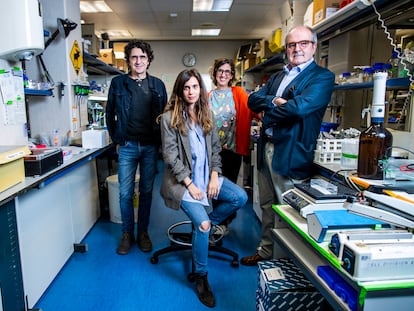The story of the girl who overcame encephalitis twice: ‘It’s as if I lived through it in a coma’
A new documentary narrates the inspiring experience of Marta Huertas, aiming to bring visibility to a rare disease that affects one person in every 250,000


Almost seven years ago, the lives of Marta Huertas and her family changed completely. This young woman from Orihuela, Spain, now 18, suffered twice from encephalitis when she was 11: the first time it was an infectious type, caused by the herpes simplex virus (HSV), while the second was of autoimmune origin and arose as a consequence of the first. In a matter of weeks Marta stopped walking, talking and eating on her own. She spent months in the hospital and required a combination of treatments, including chemotherapy, and rehabilitation to recover. The documentary Mirar al miedo (Looking at fear), premiered on February 17 and tells Marta’s story, aiming to bring attention to this rare disease which, in the case of herpetic encephalitis affects one person in every 250,000 per year worldwide, according to Orphanet, a European database for rare diseases.
The story is told by her parents, because she remembers practically nothing from that time. “It’s as if I lived through it in a coma.” When she recognized herself again, she was almost 14. It was shocking: “As if I had gone to bed and when I woke up I had another body and another personality,” she says.
Encephalitis is an inflammation of the brain that has multiple causes and can lead to neuronal damage. The condition cannot be predicted and can happen to any person at any age, according to Thaís Armangué, a researcher at the August Pi i Sunyer Biomedical Research Institute (IDIBAPS) of the Hospital Clínic in Barcelona, who treated Marta. In her case, it was initially caused by the herpes simplex virus, the same one that frequently causes the appearance of canker sores in the mouth. “In a very small percentage of patients – in many cases it is not known why – it can cause this serious illness,” says Armangué, who is also head of neuroimmunology at the Sant Joan de Déu hospital in Barcelona.
Marta had to spend almost three weeks in the pediatric ICU of the Dr. Balmis General Hospital, in the city of Alicante, due to the herpetic encephalitis, after being referred there from her hometown’s Hospital Comarcal de la Vega Baja, where the doctors had already started treatment with acyclovir, an antiviral drug.
This is a worldwide protocol. Faced with the suspicion of encephalitis, this treatment is always carried out to cover the possibility that it is herpetic, explains Armangué. The disease is very serious and entails a race against time, so starting the treatment as soon as possible can change the prognosis. “Before acyclovir, more than 70% of patients used to die,” the neuropediatrician points out.
It was as if I had gone to bed and when I woke up I had another body and another personality”Marta Huertas
After that first process, Marta improved and was discharged. However, her family sensed that something was not right: she seemed downhearted and displayed some strange behaviors. “She moved the couches a lot and asked the time non-stop, as if she had OCD [Obsessive Compulsive Disorder],” recounts her mother, Fuensanta Gil. A week after returning from the hospital, she began to have trouble walking until, a couple of days later, she was practically unable to move her right leg.
Her parents decided to take her back to the Alicante Hospital and, 48 hours later, she was not eating or speaking; she could not do anything on her own, explains Gil. They admitted her back to the ICU, where she spent almost a month and a half. Her doctors knew it was autoimmune encephalitis but not what kind, and started treatment with immunotherapy. The answer was provided by Dr. Armangué and researcher Josep Dalmau from the IDIBAPS.

“It was our daughter’s salvation”
An acquaintance told the family about the work of Dalmau, who has discovered 11 of the 17 types of autoimmune encephalitides known to date. Gil found his email address online and contacted him to talk about Marta’s case. With that, a new door opened for the Huertas family: “He suggested that my daughter’s doctors contact him, because he was willing to help us,” recalls the mother, moved.
Two months later, they referred Marta to the Sant Joan de Déu hospital. At that time, her mother says, she always needed two people to take care of her: “She was like a baby, had to be fed, had trouble walking, wore a diaper and didn’t speak.” In addition, she would stare catatonically into space, and if she was put in a position, she was unable to change it.
In Barcelona, Marta’s second ailment received a name: she had postherpetic autoimmune encephalitis. This is a complication that occurs in 25% of patients with this type of viral encephalitis and has a mortality rate of approximately 5%. Marta’s body had developed a “misdirected” immune response against NMDA receptors in the brain, which are involved in functions such as learning and memory, explains Dalmau. In these cases the prognosis is even more uncertain, because the brain has already been damaged by the virus, adds Armangué.
She was like a baby, had to be fed, had trouble walking, wore a diaper and didn’t speak”Fuensanta Gil, Marta Huertas' mother
In older children, like Marta, the disease manifests itself through behavioral changes, which made her act in a completely uninhibited and unusual way: “She spent an entire day doing sit-ups in the hospital,” says her mother.
The team decided to try a more aggressive treatment for Marta, who a few months earlier had turned 12 in the ICU. For six months, she received chemotherapy every 21 days at the Alicante hospital under the supervision of Armangué. “After the first session she was already like a different person,” says her father, Kiko Huertas. Marta was already building Lego constructions when they went to the second session. “For us it was spectacular; it was our daughter’s salvation,” say her parents, thrilled.
Armangué explains that each patient’s procedure depends on the cause of the encephalitis. Until now, for the autoimmune type, corticosteroids and sometimes immunoglobulins were generally used. “Understanding the underlying mechanisms is helping us to treat them in a more specific manner,” she says. When Marta arrived in Barcelona, she had already received some of these medications. However, given the lack of response and the certainty that it was an autoimmune complication, they recommended a more aggressive strategy that ended up working.
Doctors need to be realistic with each patient’s relatives and curb their expectations, Armangué emphasizes. “Marta’s story is beautiful, but there are younger children with this complication whose response is not as good, even if we use aggressive treatments, so research into its prevention needs to continue.” That is one of the matters that she and Dalmau are trying to solve: why some people do not get results – or not the results they want.

In addition to the hospital procedure, Marta required rehabilitation to recover. Every day for six months her mother took her to a clinic in Alicante, from 8.00am to 3.00pm, where she relearned how to walk and talk.
Today Marta is a completely independent person, although due to the encephalitis she has dyslexia and, since 2020, an epilepsy that she controls with medication. She had wanted to tell her story in some way for a long time to give visibility to these rare diseases; that is why the documentary has been “a gift,” says her mother. The film has helped her learn about the process that she and her family went through, and she hopes that her story will help and bring faith to other people who are going through the same thing as her.
Sign up for our weekly newsletter to get more English-language news coverage from EL PAÍS USA Edition
Tu suscripción se está usando en otro dispositivo
¿Quieres añadir otro usuario a tu suscripción?
Si continúas leyendo en este dispositivo, no se podrá leer en el otro.
FlechaTu suscripción se está usando en otro dispositivo y solo puedes acceder a EL PAÍS desde un dispositivo a la vez.
Si quieres compartir tu cuenta, cambia tu suscripción a la modalidad Premium, así podrás añadir otro usuario. Cada uno accederá con su propia cuenta de email, lo que os permitirá personalizar vuestra experiencia en EL PAÍS.
¿Tienes una suscripción de empresa? Accede aquí para contratar más cuentas.
En el caso de no saber quién está usando tu cuenta, te recomendamos cambiar tu contraseña aquí.
Si decides continuar compartiendo tu cuenta, este mensaje se mostrará en tu dispositivo y en el de la otra persona que está usando tu cuenta de forma indefinida, afectando a tu experiencia de lectura. Puedes consultar aquí los términos y condiciones de la suscripción digital.
More information
Archived In
Últimas noticias
Most viewed
- Oona Chaplin: ‘I told James Cameron that I was living in a treehouse and starting a permaculture project with a friend’
- Reinhard Genzel, Nobel laureate in physics: ‘One-minute videos will never give you the truth’
- Sinaloa Cartel war is taking its toll on Los Chapitos
- Why the price of coffee has skyrocketed: from Brazilian plantations to specialty coffee houses
- Silver prices are going crazy: This is what’s fueling the rally










































